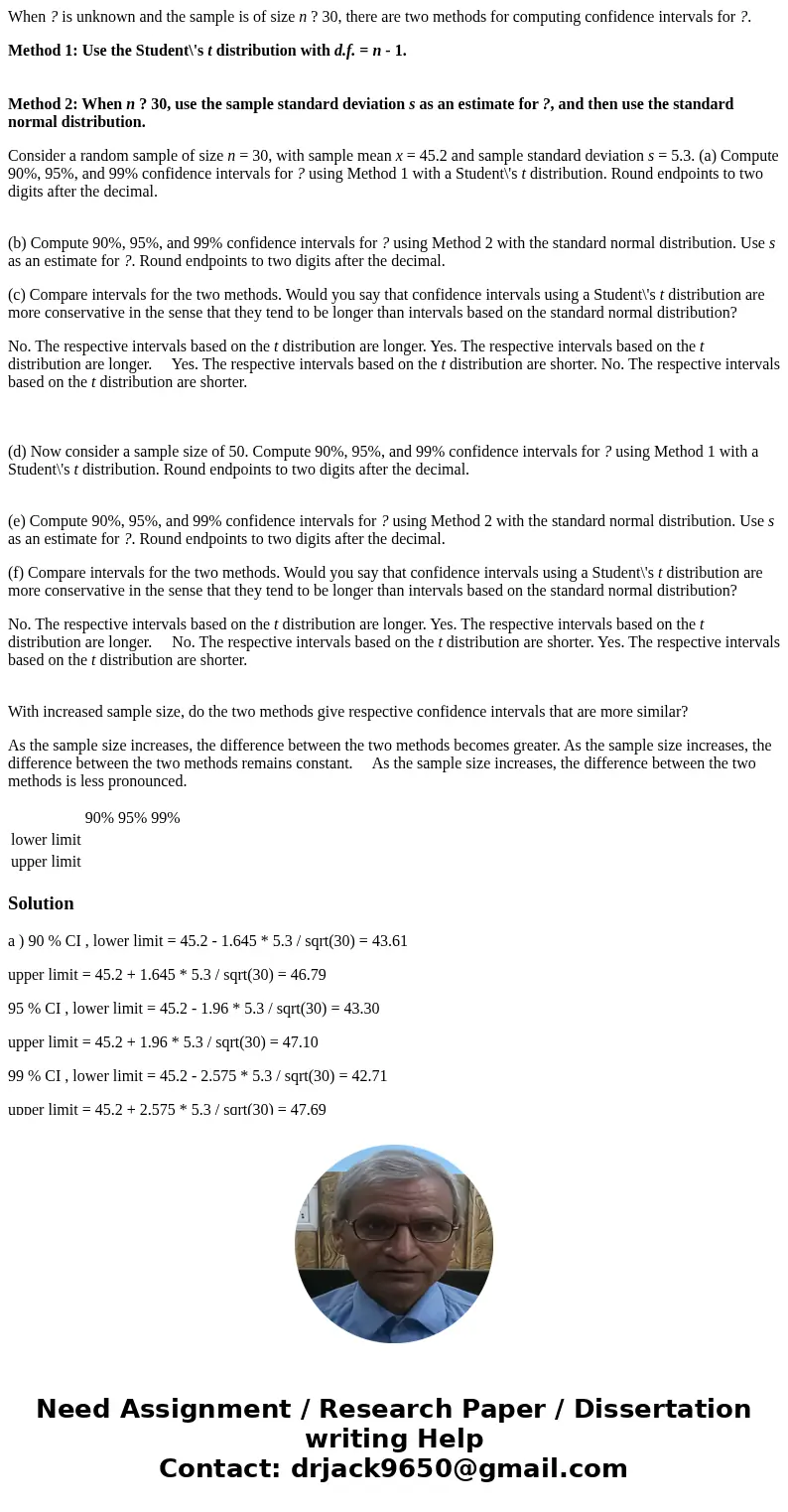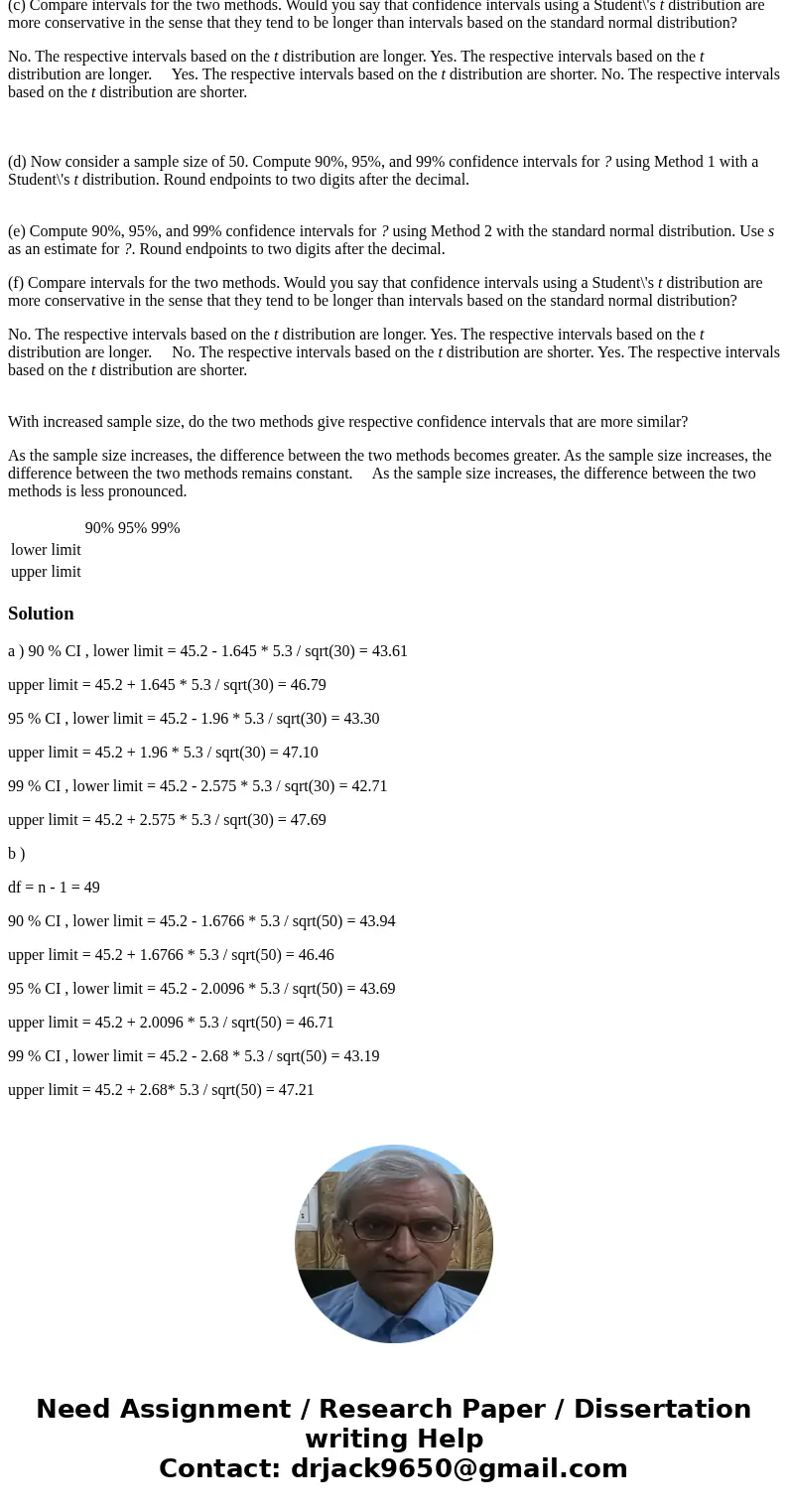When is unknown and the sample is of size n 30 there are t
When ? is unknown and the sample is of size n ? 30, there are two methods for computing confidence intervals for ?.
Method 1: Use the Student\'s t distribution with d.f. = n - 1.
Method 2: When n ? 30, use the sample standard deviation s as an estimate for ?, and then use the standard normal distribution.
Consider a random sample of size n = 30, with sample mean x = 45.2 and sample standard deviation s = 5.3. (a) Compute 90%, 95%, and 99% confidence intervals for ? using Method 1 with a Student\'s t distribution. Round endpoints to two digits after the decimal.
(b) Compute 90%, 95%, and 99% confidence intervals for ? using Method 2 with the standard normal distribution. Use s as an estimate for ?. Round endpoints to two digits after the decimal.
(c) Compare intervals for the two methods. Would you say that confidence intervals using a Student\'s t distribution are more conservative in the sense that they tend to be longer than intervals based on the standard normal distribution?
No. The respective intervals based on the t distribution are longer. Yes. The respective intervals based on the t distribution are longer. Yes. The respective intervals based on the t distribution are shorter. No. The respective intervals based on the t distribution are shorter.
(d) Now consider a sample size of 50. Compute 90%, 95%, and 99% confidence intervals for ? using Method 1 with a Student\'s t distribution. Round endpoints to two digits after the decimal.
(e) Compute 90%, 95%, and 99% confidence intervals for ? using Method 2 with the standard normal distribution. Use s as an estimate for ?. Round endpoints to two digits after the decimal.
(f) Compare intervals for the two methods. Would you say that confidence intervals using a Student\'s t distribution are more conservative in the sense that they tend to be longer than intervals based on the standard normal distribution?
No. The respective intervals based on the t distribution are longer. Yes. The respective intervals based on the t distribution are longer. No. The respective intervals based on the t distribution are shorter. Yes. The respective intervals based on the t distribution are shorter.
With increased sample size, do the two methods give respective confidence intervals that are more similar?
As the sample size increases, the difference between the two methods becomes greater. As the sample size increases, the difference between the two methods remains constant. As the sample size increases, the difference between the two methods is less pronounced.
| 90% | 95% | 99% | |
| lower limit | |||
| upper limit |
Solution
a ) 90 % CI , lower limit = 45.2 - 1.645 * 5.3 / sqrt(30) = 43.61
upper limit = 45.2 + 1.645 * 5.3 / sqrt(30) = 46.79
95 % CI , lower limit = 45.2 - 1.96 * 5.3 / sqrt(30) = 43.30
upper limit = 45.2 + 1.96 * 5.3 / sqrt(30) = 47.10
99 % CI , lower limit = 45.2 - 2.575 * 5.3 / sqrt(30) = 42.71
upper limit = 45.2 + 2.575 * 5.3 / sqrt(30) = 47.69
b )
df = n - 1 = 49
90 % CI , lower limit = 45.2 - 1.6766 * 5.3 / sqrt(50) = 43.94
upper limit = 45.2 + 1.6766 * 5.3 / sqrt(50) = 46.46
95 % CI , lower limit = 45.2 - 2.0096 * 5.3 / sqrt(50) = 43.69
upper limit = 45.2 + 2.0096 * 5.3 / sqrt(50) = 46.71
99 % CI , lower limit = 45.2 - 2.68 * 5.3 / sqrt(50) = 43.19
upper limit = 45.2 + 2.68* 5.3 / sqrt(50) = 47.21


 Homework Sourse
Homework Sourse